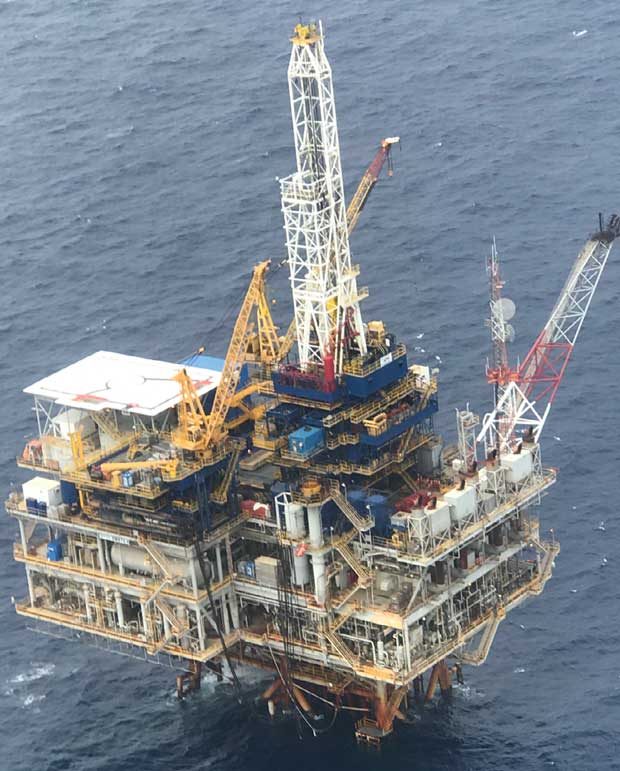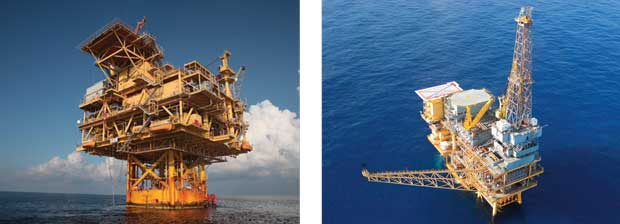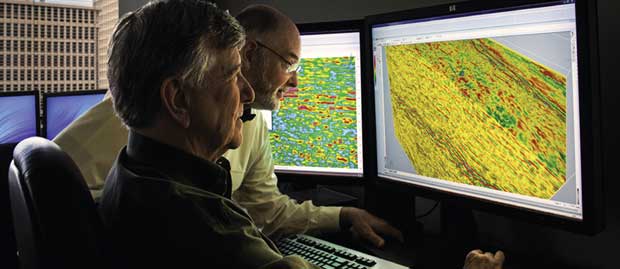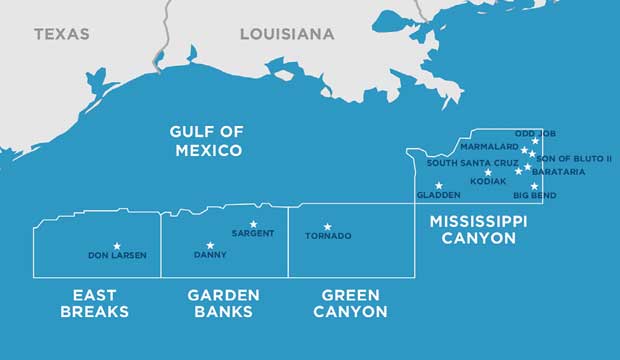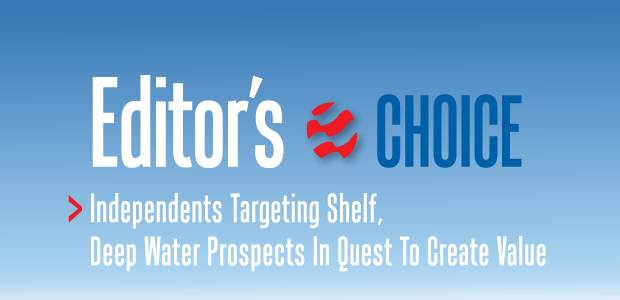
Independents Targeting Shelf, Deep Water Prospects In Quest To Create Value
By Danny Boyd, Special Correspondent
The results of Gulf of Mexico Lease Sale 252, held March 20, showed encouraging signs, most notably the fact that the $244 million in high bids was effectively double the high bid totals generated at both Sale 250 in 2018 and Sale 249 in 2017. As usual, the lists of most active bidders and biggest spenders at Sale 252 was a mix of independents and majors. Tracts in more than 2,600 feet of water drew 70 percent of all the bids, but blocks in the shallowest water depths also attracted attention, according to the U.S. Bureau of Ocean Energy Management.
Shell was far and away the most active company, submitting $84.8 million in high bids on 87 blocks. Anadarko Petroleum tendered the second greatest number of high bids–27–totaling $24 million, BOEM data show, followed by BP (23 high bids totaling $15.45 million), W&T Offshore (15 high bids and $3.5 million), Hess Corporation (12 high bids and $17.9 million), Kosmos Energy (nine high bids and $11.2 million), Chevron (eight high bids and $12 million), Fieldwood Energy (eight high bids and $3.7 million), Beacon Offshore Energy Exploration (seven high bids and $5.3 million), and LLOG Exploration (seven high bids and $4.3 million).
Digging deeper into the sale’s results shows that the overwhelming majority of high bids by both independents and majors were submitted on a 100 percent working interest basis, although independents also partnered with their peers as well as major and international companies on bids for deepwater tracts. Some of the more interesting examples of the latter, and perhaps a harbinger of things to come in the Gulf, include Chevron and Fieldwood partnering 80/20 to submit high bids on Mississippi Canyon blocks 119, 163 and 206, BP and LLOG Exploration teaming 50/50 on Mississippi Canyon 346, Equinor and Kosmos bidding 50/50 on Keathley Canyon 964, and Fieldwood partnering with Ecopetrol and Talos Energy on Mississippi Canyon 904 (59, 31.5 and 9.5 percent interests, respectively).
So what activities are the subject of independents’ focus in the Gulf, a basin that ranks second only to the mighty Permian in daily oil output? What are their plans for exploring acreage acquired in recent lease sales, as well as developing existing fields and assets they have picked up through acquisitions?
At Sale 252, Houston-based EnVen Energy Corporation was high bidder on five of the six tracts for which it submitted offers, all in deep water: Mississippi Canyon 107, Green Canyon 37, and Atwater Valley blocks 399, 487 and 488. EnVen was also high bidder on five blocks at last August’s Sale 251: Grand Isle Area, South Addition 104; Ewing Bank 525; Mississippi Canyon 239; and Atwater Valley blocks 398 and 444.
But reflecting a strategy that Chief Financial Officer John Wilkirson describes as “identifying and executing drill bit opportunities in existing, adjacent and acquired mid-life deepwater assets,” the company also has made a name for itself in the Gulf acquisition and divestiture market. Beginning in late 2014, EnVen purchased Shell’s and then ENI’s interests in the Cognac Field, followed in 2015 by acquiring the Lobster, Petronius and Neptune fields from Marathon, and ExxonMobil’s interest in the Main Pass Field, and in 2016, the Brutus and Glider fields from Shell.
Transformative Acquisitions
“The Marathon and the 2016 Shell deals were both transformative property acquisitions that set us up for long-term organic growth through the drill bit,” Wilkirson says, noting that after closing on the Brutus and Glider deals, EnVen launched multiwell platform drilling programs at both the Lobster and Brutus fields.
EnVen Energy Corporation was high bidder on five deepwater blocks at Sale 252 in March, as well as five blocks at last August’s Sale 251. The company also has made a name for itself in the Gulf acquisition and divestiture market with a series of acquisitions of producing deepwater properties, including “transformative acquisitions” of the Lobster, Petronius and Neptune fields from Marathon, and the Brutus and Glider fields from Shell. Shown here is the Lobster Field platform in Ewing Bank 873.
“Our strategy has been to be fairly choosy and acquire assets, preferably through direct negotiations with the seller,” Wilkirson says. “We seek assets that we can operate, are oily, have upside reserve potential and come with facility infrastructure. Lately, it has been a buyer’s market in the limited number of companies looking to acquire assets, which has been beneficial to us.”
He adds that EnVen plans to continue keeping an eye out for attractive asset acquisition opportunities while also participating in federal lease sales, conducting exploration drilling on new leases, and maintaining active development drilling programs in existing fields.
The platform drilling programs are primarily multiwell recompletions and sidetracks targeting unbooked reserves, and are among 70 identified drill bit projects in the company’s inventory, Wilkirson says. EnVen is drilling three-four wells this year at Cognac, and plans to drill 8-12 wells overall from its operated platforms.
Last December, the Transocean Pontus drill ship was mobilized to Green Canyon Block 248 in EnVen’s Glider Field to execute its GL-5ST2 sidetrack, an offset to the GL-5ST1 that had been producing for four years before it went off line in 2015 because of a mechanical failure. The GL-5ST2 targets the same oil reservoir, the J sand, as the GL-5ST1. Reservoir modeling and proprietary 4-D seismic analysis substantiated significant reserves remaining in the J Sand, Wilkirson says.
“We have successfully sidetracked the well and finished completion operations. The GL-5ST2 is now on production making more than 4,000 barrels of oil equivalent a day,” he reveals. “We are still monitoring the pressures in the well. It can likely produce more than that, but we are being very careful because of the history of the prior completion and wanting to make sure we do not bring it on too fast.”
Also on EnVen’s 2019 schedule are two subsea exploration wells, including Mt. Ouray, a 1,000-plus acre Upper Miocene-age amplitude anomaly prospect in a suprasalt minibasin in Green Canyon 723/767, Wilkirson relates. EnVen is operator of Mt. Ouray, holding a 40 percent working interest with Ridgewood Energy as a nonoperating partner. Wilkirson says Mt. Ouray is expected to spud in the third quarter.
“The multiwell platform drilling programs allow us to target unbooked reserves from our existing infrastructure with the advantages that platform rig day rates are much lower compared with floating rigs, and first production begins within days of completing rig operations,” Wilkirson states. “The subsea exploration opportunities add scale and diversity.”
EnVen’s 2019 capital expenditure budget is $250 million-$300 million, and the company is expected to be free cash flow positive for the fourth consecutive year, Wilkirson notes, adding that the company expects 2019 daily production to average 30,000-34,000 boe/d, up from 2018’s average of 29,000-30,000 boe/d.
Expanded Acreage Position
W&T Offshore Inc. was the fourth most active bidder at Sale 252, submitting the high bids on 15 blocks covering 73,500 acres. Eight of the blocks are in deep water (Garden Banks 173, Green Canyon 3, 46, 47, 49, 91 and 92, and Mississippi Canyon 244) and seven are in shallow water (Eugene Island 357, 378, 393, 395 and 396, Main Pass 286, and South Marsh 205), notes Tracy W. Krohn, W&T’s chairman and chief executive officer.
“We are very pleased to expand our acreage by being the apparent high bidder on 15 blocks. Over the past 35 years, we have developed significant technical experience and have successfully discovered and produced properties on the conventional Shelf and in deep waters across the Gulf,” Krohn states. “We utilized our proprietary seismic to determine the blocks we felt complemented our current acreage and extended known discoveries in the subsalt. We also believe that focusing on acreage around our production facilities allows for more economic and quicker development of potential discoveries.”
Reflecting W&T Offshore’s balanced approach to add reserves through the drill bit both on the Shelf and in deep water, the company was high bidder on eight deepwater blocks and seven shallow-water tracts at Sale 252 in March. Shown here at left is W&T’s tension leg platform stationed in the deepwater Matterhorn Field in Mississippi Canyon 243, and at right is the Mahogany platform in Ship Shoal 349/359 on the Shelf.
Executive Vice President William Williford, general manager of Gulf of Mexico operations, says W&T’s approach at Sale 252–bidding on blocks at both ends of the water depth spectrum–is the result of its “balanced approach” to add reserves through the drill bit both on the Shelf and in deepwater plays. At last August’s Sale 251, the company was top bidder on two leases in the High Island area and two in the Main Pass area.
“We are not active only in deep water or on the Shelf,” Williford explains. “We go to lease sales mainly to get leases in and around current infrastructure; that is how we look at leasing opportunities. They could be in deep water or on the Shelf, as long as we can create value with them. We have bought quite a bit of acreage on the Shelf in and around current infrastructure and recently drilled wells in fields that had not seen drilling in 10 years.”
Finding new reserves in Shelf properties is creating a growth engine even as the company continues to identify deepwater subsalt prospects, he adds. W&T has more than 515,000 gross acres on the Shelf that have generated about 60 percent of the company’s total production of 36,500 boe/d in 2018, Williford says.
“When you think about the Shelf, you think about the infrastructure and the lower-cost environment,” he explains. “It gives us the opportunity to grow production through workovers and recompletions with a lot of additional uphole potential at a lower cost, and requires less time to get production on line compared with deep water.”
Current Projects
W&T has drilled and completed 13 wells at its operated Mahogany Field in Ship Shoal 349/359. The latest is the A-19 well, which was completed in the “T” sand and brought on line in the fourth quarter. “The A-19, which is updip from the T sand first discovered in the A-14 well, logged exceptionally high-quality T sand pay,” Williford says. “The well was completed as a T sand producer, but has multiple zones behind pipe for future exploitation.”
W&T Offshore grew its average deepwater production more than 600 percent and proved reserves 800 percent between 2009 and 2017, and more than doubled its gross deepwater acres, mostly through acquisitions. Since 2011, the company has achieved a 93 percent success rate on more than 40 wells drilled both on the Shelf and in the deepwater Gulf.
The A-19 was brought on line using a staged production ramp up, and was producing at a controlled rate of 5,205 boe/d in mid-February, Williford reports. The A-19 is W&T’s third producer in the T sand, and has shown significantly higher rates of early production than either of the two previous wells completed in the T sand, with a productivity index more than double the best prior completion in the field, he points out.
W&T is preparing to restart the platform rig to drill the A-12 development well, also targeting the T sand, Williford says, noting that the T sand has so far yielded cumulative production of 7.2 million boe at Mahogany.
In deep water, W&T is commencing production from the A-13 well at its operated Virgo Field at Viosca Knoll 823. Williford reports that the well found 77 feet of net vertical pay in two sand intervals.
According to the company, in the nonoperated portion of the Ewing Bank 910 Field, the ST 320 A-2 well was completed and brought on line in December, but initially was flowed at a curtailed rate of 3,400 boe/d because of limited equipment capacity to handle vapor recovery on the ST 311 platform. W&T indicates it expects to resolve that issue soon to allow for the well’s continued ramp up. Meanwhile, drilling on the ST 320 A-3 was expected to reach total depth targeting a thick Miocene sand by the end of the first quarter. Williford says that W&T holds a 10.8 percent interest in Ewing Bank 910 until certain performance thresholds are met.
Defining a deepwater property as one in more than 500 feet of water, W&T grew average deepwater production more than 600 percent and proved reserves 800 percent from 2009 through 2017, and more than doubled its gross deepwater acres, mostly through acquisitions, Williford points out. “That said, we also have opportunities to tie back off-lease production to give us additional revenues, which also gives us access to higher volumes and higher reserves in that basin,” he says.
Whether in shallow or deep water, the Gulf of Mexico has plenty of upside, Williford assesses, with per-well output second to none in the United States. “A lot of people forget that the Gulf is the second highest oil producing basin, and has some of the highest-rate producing wells,” he says. “The Gulf is not on the decline, it is on the incline. We see a lot of upside and potential.”
Whether working mature assets or green-field projects, the company has built the technical expertise to successfully develop and operate fields in all water depths, as evidenced by its high drilling success rate across all water depths, says Chief Financial Officer Janet Yang.
“We have managed through every type of headwind in the Gulf of Mexico for 35 years and our success rate is 93 percent on 40-plus wells drilled since 2011,” Yang states.
Wealth Of Opportunities
Beacon Offshore Energy LLC was formed by Blackstone Energy Partners, an affiliate of Blackstone, in 2016 as an exploration and production company focused on exploring, developing, acquiring and operating upstream oil and gas properties in the deepwater Gulf of Mexico. Beacon currently holds interests in approximately 60 deepwater leases, and is transitioning to becoming a deepwater operator in 2019, says Chairman and CEO Scott Gutterman.
“The deepwater Gulf is still one of the most prolific basins in the world, providing a wealth of attractive exploration opportunities in addition to the potential for consolidation,” says Gutterman, who joined Beacon in November after 25 years at LLOG Exploration. “There are fewer companies active in the deep water today with less competition for these opportunities. Our objective is to build a high-quality asset portfolio and position the company as a leading deepwater operator and partner of choice.”
According to the company, it currently holds working interests in both producing assets and exploration positions in several deepwater plays from Mississippi Canyon to Keathley Canyon, with a focus on the Miocene and Eocene trends. Beacon’s current working interest positions range from approximately 10 to 50 percent. At March’s Lease Sale 252, the company was apparent high bidder on seven blocks in Green Canyon and Walker Ridge, with working interests ranging from 50 to 85 percent.
“We are looking to step up our pace of growth,” Gutterman remarks, noting that Beacon plans to drill two-three wells during the next several months, but hopes to increase that number later in the year as it assumes the role of operator of new ventures.
The company’s total lease position includes 213,000 gross and 53,000 net acres, and Gutterman notes that later this year, it will assume operatorship of six producing properties that LLOG currently operates.
Beacon’s net production is 10,000-11,000 boe/d on net reserves of approximately 81 million boe, he says, but the company forecast is trending upward quickly with first production at LLOG-operated Buckskin scheduled for late second quarter 2019 once tie-in is completed to the Anadarko-operated Lucius floating production facility.
Buckskin Development
Located in 6,800 feet of water at Keathley Canyon 785/828/829/830/871/872, Buckskin is an Eocene (Wilcox) development at a total depth of approximately 29,000 feet. Flow tests from the initial two development wells LLOG drilled at Buckskin have been limited, but suggest initial production rates in line with top-tier Wilcox wells, Gutterman reports. Including Buckskin and other developments coming on line near the end of the year, Beacon should exit 2019 with an additional 5,000-7,000 boe/d of net production to the company’s output, he says.
“Similar to other successful Wilcox developments, rock and fluid properties are outstanding and estimated ultimate recoveries on a per-well basis continue to rise,” Gutterman remarks.
Current development work focuses on the field’s northern portion, although the discovery well was drilled in the southern portion, he notes, which could provide the opportunity for significant additional development during the next few years.
“Considering both the north and south ends, the field is estimated to contain approximately 500 million barrels in place,” he reveals. “It is quite an undertaking to develop the entire field with a likely minimum of four-five wells, and potential for 10 or more if we bring in the south end.”
While much of the company’s anticipated growth will be organic going forward, including increasing exposure at BOEM lease sales, Gutterman says the company will remain opportunistic in its approach to inorganic options as well.
Staying The Course
Dallas-based Kosmos Energy Ltd. plans to stay the course established by Deep Gulf Energy, which it acquired last fall, by focusing on a large inventory of low-risk exploration prospects in the deepwater Gulf, says Richard Clark, senior vice president and head of Kosmos’ Gulf business unit and former president at Deep Gulf.
Kosmos Energy expects to bring three wells on production this year in the Gulf of Mexico–Tornado, Odd Job and Nearly Headless Nick–followed by South Santa Cruz and Kodiak in 2020. Kosmos is operator of Odd Job in Mississippi Canyon 214/215, South Santa Cruz at Mississippi Canyon 563 and Kodiak at Mississippi Canyon 727/771. Tornado in the Green Canyon area is operated by Talos Energy and Nearly Headless Nick in the Mississippi Canyon area is operated by LLOG Exploration.
Kosmos Energy reported in late February that it already had realized 1.5 times the $1.2 billion capital investment it made last September to purchase Deep Gulf Energy, including both operated and nonoperated holdings in the Mississippi Canyon, Green Banks, Garden Banks and East Banks areas.
The company’s goal is to become the “premier Atlantic Margin deepwater operator,” says Chairman and CEO Andrew G. Inglis. He points out that the acquisition gives Kosmos an entrance into the Gulf to complement its established operations offshore Suriname, Equatorial Guinea, Ghana, Côte d’Ivoire, Senegal and Mauritania.
Noting that Kosmos/Deep Gulf Energy has a 63 percent Gulf drilling success rate, and a Gulf track record of progressing from discovery to production in fewer than 18 months, Inglis says Kosmos’ strategy is focused on active management of a deep and diverse portfolio with a focus on value creation.
“We have demonstrated exploration excellence, executed with a rifle shot approach,” Inglis commented during a Feb. 28 conference call. “We have a rapid development cycle with a focus on payback. This is a DNA of Kosmos that makes us the partner of choice.”
The company notes its proved net reserves in the Gulf of Mexico at the end of 2018 were 51 million boe, and Kosmos expanded its inventory at Sale 251 in August with high bids alone or in partnership with other independents on seven deepwater blocks: Keathley Canyon 720, 764 and 814, Mississippi Canyon 261 and 304, and Green Canyon 437 and 852. At Sale 252 in March, Kosmos was high bidder on nine tracts: Green Canyon 899 and 900, Keathley Canyon 858 and 964, and De Soto Canyon 221, 265, 266, 310 and 617.
The company expects its Gulf production to grow to 27,000 boe/d in 2019 (up from 24,000 boe/d at the end of the third quarter of 2018), Clark reports. To accomplish its objectives, he says Kosmos expects to bring five wells on production during the next two years: Tornado, Odd Job and Nearly Headless Nick in 2019, and South Santa Cruz and Kodiak in 2020.
Kosmos is operator of Odd Job in Mississippi Canyon 214/215, South Santa Cruz at Mississippi Canyon 563 and Kodiak at Mississippi Canyon 727/771. Tornado is operated by Talos Energy at Green Canyon 280/281 (see “NMR Key to Tornado Project’s Success,” which begins on page 96), and LLOG Exploration is operator of Nearly Headless Nick in Mississippi Canyon 38.
Hub And Spoke
Short-cycle exploration and exploitation is allowing the company to continue to expand Odd Job, a 76-million boe field in 6,000 feet of water, Clark details. As operator, Kosmos holds working interests ranging from 55 to 61 percent on Odd Job wells. The company says it anticipates a test in the third quarter from a sand formation in the M48 well, with first oil expected in the fourth quarter from the MC214 No. 2 well.
Kosmos has identified and acquired interests in four prospects near Odd Job with total potential of 80 million barrels that will be drilled during the next three years, including this year at MoneyPenny, a deeper pool test on the Odd Job structure, Clark reports.
As part of Kosmos’ hub-and-spoke strategy in the Gulf, Odd Job production is transported to the Delta House production floating platform 15 miles away at Mississippi Canyon 254. Kosmos is the platform’s anchor tenant, Clark points out. With production from other tenants declining at Delta House, Kosmos hopes to ramp up its own production to take up the available space, he says.
“The two wells that we have producing at Odd Job are at constrained rates of about 14,000 boe/d,” he details. “They are capable of producing 20,000 boe/d, so that’s one of the ways that we are going to be able to keep this capacity full, just by opening these wells when capacity becomes available.”
The company hopes to employ the hub-and-spoke strategy again in Garden Banks and develop an anchor prospect in this new area called Resolution, which has an estimated reserve potential of 100 million-200 million boe, Clark indicates.
Seismic imaging conducted by BP generated Resolution and four other prospects in the area with total potential of 340 million boe, he says (incidentally, Clark notes that Kosmos acquired 25,000 square kilometers of 3-D seismic last year, which represented 16 percent of the global proprietary offshore seismic data shot by the industry). Kosmos and BP have a 50/50 partnership to exploit the area, he adds. Outside Resolution, Kosmos has an interest in 20 prospects, 15 of which it has added within the past six months through the Deep Gulf Energy acquisition as well as lease sales.
“That is more prospects than we ever have added in such a short time at Deep Gulf Energy,” Clark says. “Going forward, we expect to drill four prospects a year and average a 30 percent working interest. In 2019, we are targeting 100 million barrels net of exploration potential from the four wells we will drill in the Gulf of Mexico.”
For other great articles about exploration, drilling, completions and production, subscribe to The American Oil & Gas Reporter and bookmark www.aogr.com.







